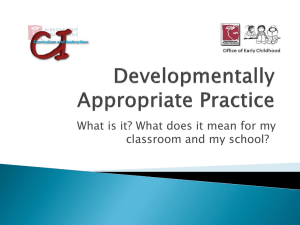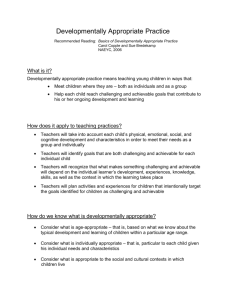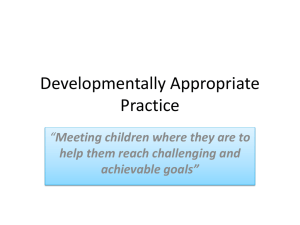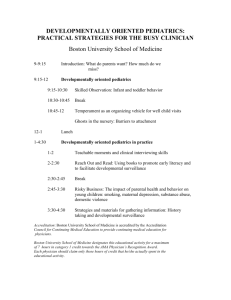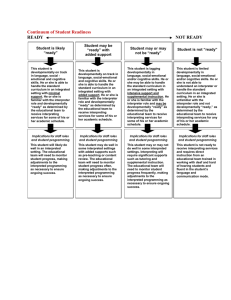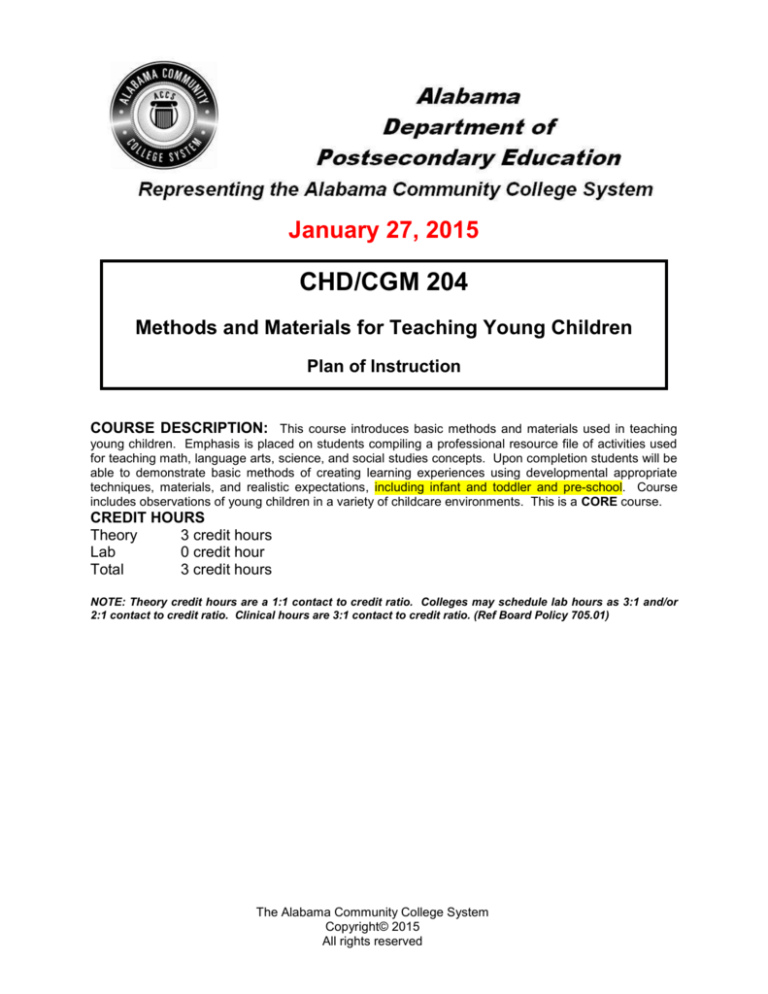
January 27, 2015
CHD/CGM 204
Methods and Materials for Teaching Young Children
Plan of Instruction
COURSE DESCRIPTION: This course introduces basic methods and materials used in teaching
young children. Emphasis is placed on students compiling a professional resource file of activities used
for teaching math, language arts, science, and social studies concepts. Upon completion students will be
able to demonstrate basic methods of creating learning experiences using developmental appropriate
techniques, materials, and realistic expectations, including infant and toddler and pre-school. Course
includes observations of young children in a variety of childcare environments. This is a CORE course.
CREDIT HOURS
Theory
3 credit hours
Lab
0 credit hour
Total
3 credit hours
NOTE: Theory credit hours are a 1:1 contact to credit ratio. Colleges may schedule lab hours as 3:1 and/or
2:1 contact to credit ratio. Clinical hours are 3:1 contact to credit ratio. (Ref Board Policy 705.01)
The Alabama Community College System
Copyright© 2015
All rights reserved
Methods and Materials for Teaching Young Children
CHD/CGM 204
PREREQUISITE COURSES
As determined by college.
CO-REQUISITE COURSES
As determined by college.
PROFESSIONAL COMPETENCIES
Evaluate existing curriculum.
Plan and organize activities that support a curriculum.
Value the need for well developed curricula and its impact on the physical,
emotional, cognitive, and social growth of young children.
Generate units of instruction with developmentally appropriate themes.
Value the use of thematic curriculum planning.
Plan implement, and evaluate developmentally appropriate activities for young
children.
Create developmentally appropriate lesson plans that foster the physical,
emotional, cognitive, and social growth of young children.
INSTRUCTIONAL GOALS
Cognitive: Comprehend foundational knowledge of methods and materials for teaching
young children from birth to age 8.
Psychomotor: Apply foundational knowledge of methods and materials for teaching
young children from birth to age 8.
Affective: Value methods and materials for teaching young children from birth to age 8.
STUDENT OBJECTIVES
Condition Statement: Unless otherwise indicated, evaluation of student’s attainment
of objectives is based on knowledge gained from this course. Specifications may be in
the form of, but not limited to, cognitive skills diagnostic instruments, manufacturer’s
specifications, technical orders, regulations, national and state codes, certification
agencies, locally developed lab/clinical assignments, or any combination of
specifications. This course is based on National Association for the Education of Young
Children (NAEYC) standards.
ACCS Copyright© 2015
All rights reserved
2
Methods and Materials for Teaching Young Children
CHD/CGM 204
STUDENT LEARNING OUTCOMES
MODULE A - PLANNING AND EVALUATING CURRICULUM
PROFESSIONAL COMPETENCIES
A1.0
Evaluate existing curriculum.
A2.0
Plan and organize activities that
support a curriculum.
A3.0
PERFORMANCE OBJECTIVES
A1.1 Evaluate an existing curriculum to
determine compliance with
National Association for the
Education of Young Children
(NAEYC) standards for
developmentally appropriate
activities and inclusion of children
with special needs.
A2.1 Plan activities that comply with
NAEYC standards for
developmentally appropriate
activities which include children
with special needs.
A3.1 This competency is measured
affectively.
KSA
Indicator
3
2
Value the need for well
developed curricula and its
impact on the physical,
emotional, cognitive, and social
growth of young children.
LEARNING OBJECTIVES
A1.1.1 Define terms associated with curriculum.
A1.1.2 Explain developmentally appropriate curriculum.
A1.1.3 Explain NAEYC standards for Developmentally Appropriate Practice
(DAP).
A1.1.4 Describe various factors that effect curriculum development.
A1.1.5 Describe the roles and responsibilities of individuals involved with
developing curriculum.
A1.1.6 Differentiate between content and process oriented approaches to
curriculum planning.
A2.1.1 Explain major components of curriculum.
A2.1.2 Explain various methods to include and provide for special needs children.
A3.1.1 State the value of curricula for meeting the developmental needs of young
children.
MODULE A OUTLINE:
Terms associated with curriculum
Developmentally Appropriate Curriculum (DAP)
NAEYC standards for DAP
Factors that effect curriculum
Roles and Responsibilities
Community issues
State and federal laws
Types of curriculum
Content
Process
ACCS Copyright© 2015
All rights reserved
A
1
2
2
3
3
3
3
3
A
3
Methods and Materials for Teaching Young Children
CHD/CGM 204
MODULE B – THEMATIC CURRICULUM PLANNING
PROFESSIONAL COMPETENCIES
B1.0 Generate units of instruction with
developmentally appropriate
themes.
PERFORMANCE OBJECTIVES
B1.1 Develop and implement thematic
units of instruction that support
developmentally appropriate
themes for various groups of
young children.
B2.1 This competency is measured
affectively.
KSA
Indicator
3
B2.0 Value the use of thematic
curriculum planning.
LEARNING OBJECTIVES
B1.1.1 Explain thematic curriculum planning.
B1.1.2 Match various instructional themes to their developmental appropriate
level of young children.
B1.1.3 Explain the use of flow charts for developing thematic curriculum.
B1.1.4 Define webbing.
B1.1.5 Explain the use of webbing.
B1.1.6 Explain techniques to include children in thematic planning.
B2.1.1 State the value of thematic curriculum planning and its impact on the
physical, emotional, cognitive, and social growth of young children.
MODULE B OUTLINE:
Themes for early childhood
Themes for unit development
Flowcharting
Webbing
Children’s involvement in thematic planning
ACCS Copyright© 2015
All rights reserved
A
2
3
2
1
3
3
A
4
Methods and Materials for Teaching Young Children
CHD/CGM 204
MODULE C – DEVELOPMENTALLY APPROPRIATE ACTIVITIES AND MATERIALS
KSA
PROFESSIONAL COMPETENCIES
PERFORMANCE OBJECTIVES
Indicator
C1.0 Plan, implement, and evaluate C1.1 Develop, implement, and
3
developmentally appropriate
evaluate activities that support
activities for young children.
a variety of learning
experiences.
LEARNING OBJECTIVES
C1.1.1 Explain various techniques for integrating developmentally
3
appropriate activities into learning experiences for young children.
C1.1.2 Explain various techniques for integrating developmentally
3
appropriate activities into arts, sensory, and motor development in
young children.
C1.1.3 Explain methods for supporting thematic units.
3
C1.1.4 Identify various materials and manipulatives for developmentally
1
appropriate activities for young children.
C1.1.5 Describe various techniques for evaluating developmentally
3
appropriate activities and materials.
MODULE C OUTLINE:
Integrating activities and subjects
math
science
language arts
social studies
Integrating arts and sensory and motor development
Art
Music
Cooking
Dramatic play
Sensory and motor development
Supporting thematic units
Materials and manipulatives
Evaluation techniques
ACCS Copyright© 2015
All rights reserved
5
Methods and Materials for Teaching Young Children
CHD/CGM 204
MODULE D – LESSON PLANNING
PROFESSIONAL COMPETENCIES
PERFORMANCE OBJECTIVES
D1.0 Create developmentally
D1.1 Develop, implement, and
appropriate lesson plans that
evaluate a variety of
foster the physical, emotional,
developmentally appropriate
cognitive, and social growth of
lesson plans for young
young children.
children.
LEARNING OBJECTIVES
D1.1.1 Explain the purpose of various lesson plan components.
D1.1.2 Describe activities appropriate for developing various skills.
D1.1.3 Describe various resources for content and support of lesson plans.
D1.1.4 Explain the value and rationale for using lesson plans.
D1.1.5 Describe various methods for evaluating the effectiveness of lesson
plans.
D1.1.6 Describe the use of technology in developing, implementing, and
evaluating lesson plans.
MODULE D OUTLINE:
Lesson plan components
Goals
Learning objectives
Concepts
Materials needed
Motivation
Procedures
Closure/transition
Evaluation
Activities for developing various skills
Resources for content and support of lesson plans
Using lesson plans
Value
Rationale for using lesson plans
Methods of evaluation
Integrating technology
ACCS Copyright© 2015
All rights reserved
KSA
Indicator
2
2
3
2
2
3
2
6
Methods and Materials for Teaching Young Children
CHD/CGM 204
LEARNING OUTCOMES TABLE OF SPECIFICATIONS
The table below identifies the percentage of learning objectives for each module.
Instructors should develop sufficient numbers of test items at the appropriate
level of evaluation.
Limited
Knowledge and
Proficiency
KSA
Module A
Module B
Module C
Module D
ACCS Copyright© 2015
All rights reserved
1
13%
17%
20%
-
Moderate
Knowledge
and
Proficiency
2
25%
33%
80%
67%
Advanced
Knowledge
and
Proficiency
3
62%
50%
33%
Superior
Knowledge
and
Proficiency
4
-
7
Methods and Materials for Teaching Young Children
Indicator Key Terms
1
Limited
Knowledge
and
Proficiency
2
Moderate
Knowledge
and
Proficiency
3
Advanced
Knowledge
and
Proficiency
4
Superior
Knowledge
and
Proficiency
A
Affective
Objective
ACCS Copyright© 2015
All rights reserved
CHD/CGM 204
Learner’s Knowledge, Skills and Abilities
Description
Recognize basic information about the subject including terms
and nomenclature.
Students must demonstrate ability to recall information such as
facts, terminology or rules related to information previously
taught.
Performs simple parts of the competency. Student requires
close supervision when performing the competency.
Distinguish relationships between general principles and facts.
Adopts prescribed methodologies and concepts.
Students must demonstrate understanding of multiple facts
and principles and their relationships, and differentiate between
elements of information. Students state ideal sequence for
performing task.
Performs most parts of the competency with instructor
assistance as appropriate.
Examines conditions, findings, or other relevant data to select an
appropriate response.
The ability to determine why and when a particular response is
appropriate and predict anticipated outcomes.
Students demonstrate their ability to seek additional information
and incorporate new findings into the conclusion and justify their
answers.
Performs all parts of the competency without instructor
assistance.
Assessing conditions, findings, data, and relevant theory to
formulate appropriate responses and develop procedures for
situation resolution. Involves higher levels of cognitive
reasoning.
Requires students to formulate connections between relevant
ideas and observations.
Students apply judgments to the value of alternatives and select
the most appropriate response.
Can instruct others how to do the competency.
Performs competency quickly and accurately.
Describes learning objectives that emphasize a feeling tone, an
emotion, or a degree of acceptance or rejection.
Objectives vary from simple attention to selected phenomena to
complex but internally consistent qualities of character and
conscience.
Expressed as interests, attitudes, appreciations, values, and
emotional sets or biases.
8

